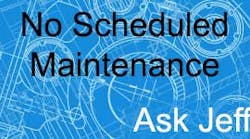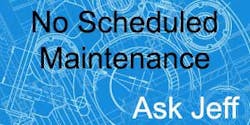Jack, maintenance supervisor, Illinois
Answer: Jack, thank you for the follow-up question.
One of our responsibilities in maintenance is to manage risk. John Moubray, in his "Reliability Centered Maintenance Second Edition" book, notes that no scheduled maintenance is valid only if:
- "A suitable scheduled task cannot be found for a hidden function, and the associated multiple failure does not have safety or environmental consequences.
- A cost-effective preventative task cannot be found for failures which have operational or non-operational consequences.’
According to engineering association SAE's JA1012 reliability-centered maintenance standard, "For failure modes that could not affect safety or the environment, failure management policies are considered in the following order: on-condition tasks, scheduled restoration/discard tasks, no scheduled maintenance, and one-time changes."
Unlike what most consider run-to-failure (RTF) for a component, we don’t forget about the item. While we may choose to not run vibration analysis on the pump bearings because of system redundancy, we would still perform basic care tasks such as lubrication and cleaning.
No scheduled maintenance does not mean no planned maintenance. We can plan for the failure by having a consequence-reduction strategy or reducing the time to repair. For example, if we choose to let the part fail, then should we stock the part to replace it to reduce the time required to restore the item to service? To facilitate the restoration, we may choose to develop a corrective job plan that outlines lockout/tagout procedures, precision procedures, and materials required.
In complex systems, when there is evidence that the proactive task does nothing to predict or prevent the failure, performing the task itself may introduce failure to an otherwise stable system. Poor workmanship and human error are examples of this effect. Consider a photo-eye sensor with operational or nonoperational consequences. Are you replacing it every year or two? Most likely, no. What proactive tasks would you choose beyond ensuring that it functions as expected and cleaning the lens/reflector when needed?
Operational or nonoperational consequences mean the failure has an economic impact only. It costs us money regarding repair, customer service, secondary damage, and downtime as examples. We consider on-condition tasks and scheduled restoration/discard tasks to be proactive tasks. If we cannot find a proactive task that meets both the technically feasible and "worth doing" questions, then no scheduled maintenance is the next choice on in the RCM2 decision logic tree. In the case where the repair costs are too high, then the secondary default decision is redesign.
What are your thoughts? Please leave your comments below.
Talk soon,
Jeff
If you have questions in the fields of maintenance, reliability, planning and scheduling, MRO storerooms, or leadership as examples, please contact Jeff Shiver with your question(s) here.


